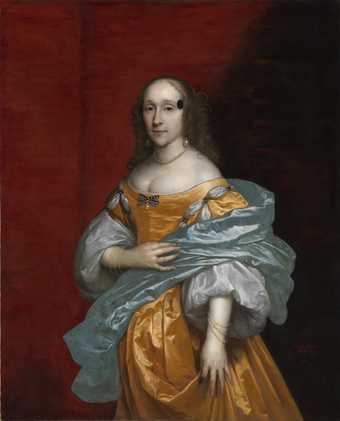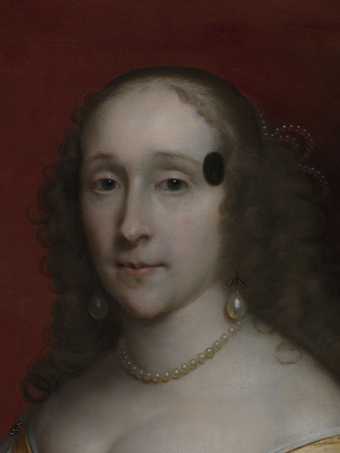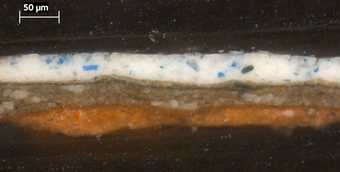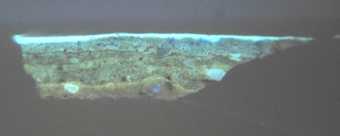The painting is in oil paint on canvas measuring 1246 x 1010 mm (figs.1–2). The linen canvas is plain woven and has approximately 31 threads each way per square centimetre. There is cusping of the canvas weave on all edges, indicating that the painting has not been reduced in size (fig.3).1
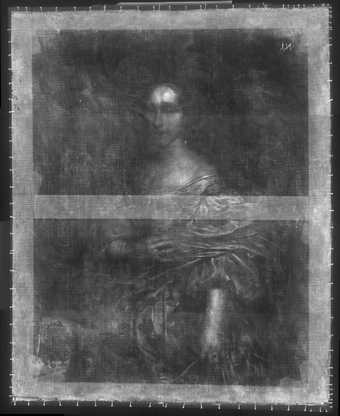
Fig.3
X-radiograph of Portrait of an Unknown Lady 1659
The painting has a glue-composition lining, which probably dates from the late nineteenth century, and an adjustable wooden stretcher of the same date. The original tacking edges are not present on the painting; probably they were removed at the time of lining. On the reverse of the lining canvas there is a circular stamp with a central crest, marked ‘Wien’ (fig.4). The inscription of another, smaller circular stamp is illegible. Laterally inverted initials ‘N.J.’ are visible at the top right corner of the painting in X-radiography; they are inscribed on the reverse of the original canvas, now masked by the lining.
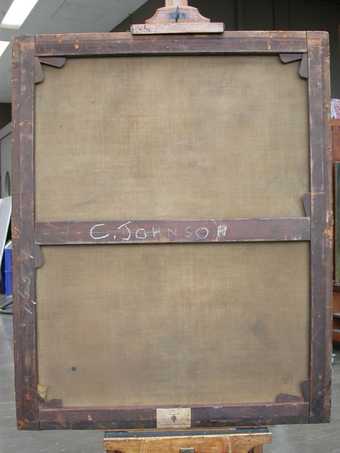
Fig.4
The back of Portrait of an Unknown Lady 1659
There is a double ground, of which the first layer, applied directly to the canvas, is deep opaque orange colour, composed of earth colours bound together in oil. This layer is covered over with a coat of opaque mid-grey paint, which is composed of bone black, lead white and earth colours (fig.5). Its uneven thickness in cross-section indicates a vigorous, brushy application.
Neither surface microscopy nor infrared reflectography show evidence of underdrawing. Underpainting is evident beneath the red curtain; the opaque red bodycolour is painted on top of opaque dark, bluish grey paint (fig.5). Cross-sections through the blue sash show very thin, dark grey underpaint beneath the yellow tones of the dress (figs.6–8). The gold colour of the dress is a mixture of lead-tin (or Naples) yellow, yellow lake, yellow and red earth colours and lead white. The red curtain was laid in first with opaque vermilion bodycolour, then glazed when dry with translucent red lake, made from cochineal insects.2 The blue of the sash has undergone change over the years, becoming flat and greyish in the highlit areas and dull greenish blue in the shadows (fig.9). This alteration appears to be a combination of two factors: ‘ultramarine sickness’ in the highlit areas, where the principal blue pigment is natural ultramarine, and the deterioration of smalt in the shadows, where smalt is present as well as ultramarine. Neither form of deterioration is reversible.

Fig.9
The sash, showing dark, greenish blue patches of discoloured smalt
Before the painting was cleaned and restored in 2009 the dark ‘beauty patch’ on the sitter’s left temple was covered over with flesh-coloured paint (fig.10). During the process of cleaning the painting, this paint was analysed and was found to contain Prussian blue and chrome yellow among the pigments making up the colour.
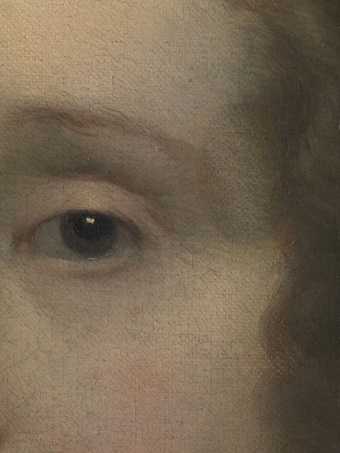
Fig.10
Detail of the overpainted ‘beauty patch’ on the sitter’s temple, before restoration
As the first was not available until the early eighteenth century and the second until the early nineteenth century, this paint was removed to reveal very well preserved original paint beneath it. The overpainting had therefore been done on grounds of changes in fashion.
July 2009

